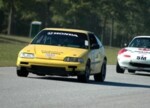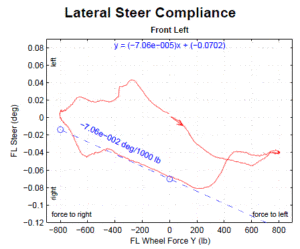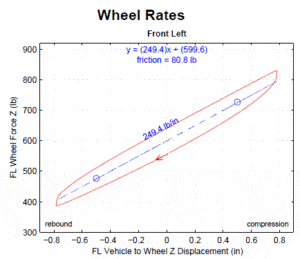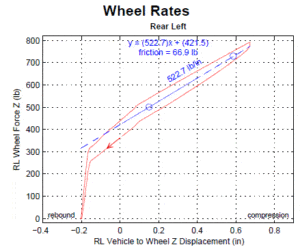
A Case Study in K&C Testing
A Case Study in K&C Testing
This K&C testing case study shows how kinematics and compliance testing can be applied to a race car. Since we’re careful to keep client information confidential, this study uses former in-house engineer Mike’s Honda CRX Si, which he raced in NASA’s Honda Challenge H2 class.
Goals and Objectives
The subject vehicle is a Honda CRX Si racing in NASA’s Honda Challenge H2 class. The specific goals will focus on this vehicle, but the fundamental concepts can be applied to any production-based race car and will illustrate how K&C testing can be used with any type of vehicle.
The overall objective is to use kinematics and compliance data to improve the vehicle from a suspension and handling perspective. The first goal will be to see what information about the car can be learned through a baseline K&C characterization, and what correlations can be made between the data and the behavior of the car on track. Working with this baseline data, what changes can be made to improve the vehicle? Based on Mike’s experience on track with the car, there are no major problems with the car that need to be specifically addressed. The balance of the car is good in both low and high speed corners, and the overall grip level is high. Under braking the car runs straight and is stable, and there are no problems with wheel-spin or putting power down on corner exit. The vehicle is fundamentally ok, but that doesn’t mean there are no more changes that can be made to improve the handling of the car, whether in overall grip or drivability.
One popular addition to production-based race and street cars are bolt-on chassis braces. They come in a variety of shapes to suit various locations on the car, and a variety of price tags as well. The manufacturers claim improved turn-in response as well as stiffening the suspension pickup points that the brace bolts to, improving overall grip. With so many people swearing by dramatic increases in vehicle handling due to the addition of these braces, a back to back test on the K&C rig seems like the perfect way to put some concrete numbers on the effectiveness of such braces. Mike’s car has a front upper brace spanning between the upper shock mounts, and a rear lower brace that bolts on to the lower control arm inner mounting points. By simply running tests with and without the braces connected, their effect can be measured and objectively evaluated. In addition to the baseline data, there are a few items of specific interest. As a front wheel drive production-based race car, the rear has higher roll stiffness than the front to help with traction while cornering and to mitigate understeer. This can cause the inside rear to lift during hard cornering, which can result in excessive body roll. With a few different tests on the K&C machine the effects of this can be measured not only in terms of vertical wheel loads, but the effect of the body motion on the wheel positions as the car moves. Mike’s CRX was set up for racing without any anti-roll bars. The overall balance of the car is very good and he hasn’t added any bars for fear of disrupting that balance and causing too much understeer or oversteer. Mike has a few options as far as springs and anti-roll bars available on hand, and a few combinations of those will be tested to see what will give the chassis the most body control, as well as the right balance, in cornering.
There is no shortage of things to improve on a race car, and these are just a few of the things that can be studied on the K&C rig. Some are specific to production-based race cars, while others apply to all types of vehicles. Like any baseline test, just getting to see the data will reveal many things about the car that were previously unknown. Some questions will get answered and others will be raised, but something new is always in store.
Finally, like many race cars that started life as street cars, the CRX has had the OEM rubber bushings replaced with polyurethane to help with bushing compliance. They incorporate a metal sleeve that slides inside the polyurethane bushing; the sleeve is lubricated with silicone. The bushings can have high friction as the sleeve must rotate inside the bushing, and any misalignment of the suspension joints will cause the friction between the sleeve and the bushing to be even higher. The sensitivity of the K&C machine allows it to measure the friction in the suspension as it travels, as well as uncover any increase in friction as load is applied to the suspension in cornering. Honda Challenge rules allow replacement of the suspension joints with spherical bearings, and this would likely decrease both the friction and compliance of the suspension.
Test Results
The results are in! Mike’s Honda CRX went on the K&C machine and the data has been processed. As with every K&C test we learned things we didn’t expect, some of which were pleasantly surprising and some that will be addressed. The baseline tests gave a thorough characterization of the car and quickly indicated what areas need to be improved and what is already good. Making part changes on the rig provided hard numbers on the window of adjustment that is available, showing which parts make a significant difference and which really do not. Briefly, here is the information we got from a baseline test that can help improve the car, what effect the bolt-on chassis braces have on the measurable parameters of the car, and what effect the polyurethane bushings have on the compliance and friction of the suspension.
The first set of tests done on the CRX was the baseline which revealed an enormous amount of information about the car. In the past, for a production-based race car the majority of this information was unknown and was either painstakingly measured or guessed at with as much information as was available. But by using the K&C rig nearly every aspect of the suspension is uncovered within a couple of hours. Most aspects of the car looked very good. There was almost no bump steer, the roll centers were above ground and well controlled, and the compliance tests showed that steer compliance was excellent (see Figure 1, above). The stiffness of the steering system owes itself partly to the less aggressive kingpin offsets found in the steering system, as the car has manual steering. Finding areas of the car that don’t need any work is almost as good as finding areas that do as it allows you to focus your efforts where they will do the most good. On the CRX one area that needs improvement is the camber compliance. Even with the stiffer polyurethane bushings it showed a large amount of camber change under cornering load, with the rear experiencing approximately twice as much movement as the front. Since the rear has two poly bushings in the lower control arm, as opposed to the one on the front lower arm, we can bet that the bushings are contributing a large amount of the compliance measured at the wheel.
The polyurethane bushings had an effect in another area: friction. Each wheel showed around 80 lb of friction (see Figure 2, below). This is a lot, although even purpose built race cars can have friction exceeding 60 lb. It is clear that the CRX could benefit greatly from spherical bearings in the control arms, both to reduce friction and camber compliance under cornering load. The friction was fairly consistent over various load ranges from highly loaded 1G turns to having the springs removed from the car, indicating that the friction is not very sensitive to vertical load.
The bolt-on chassis bracing mentioned in the first article was tested as well. The car has a front upper and rear lower bolt-on brace, and after the baseline test was complete they were disconnected and a few tests were run to see their effect. The braces had no effect on wheel rates in bounce and roll, and in the compliance tests the results were barely noticeable. The largest difference was in the lateral opposed test where cornering forces are applied in opposite directions on either side of the vehicle. In this test the rear brace showed a difference of a couple hundredths of a degree of camber per 1000 lb of cornering force, while the front indicated a very slight increase in stiffness with the brace removed. The bottom line is that these braces added weight and cost but provided no practical performance improvement.
Given the nature of the braces on this car, which bridge between two parts of the car without triangulating to a third point, it’s not hard to imagine that their effectiveness would be minimal. But based on the number of personal accounts by people who have installed the bars and report huge increases in vehicle responsiveness and handling the only true way to determine the value of the bars is to do a back to back comparison on the K&C machine.
One aspect of the car that will require some attention is the amount of wheel travel available. On the front, the right side was limited in bounce travel because the upper ball joint hit the underside of the shock tower, and the left side wasn’t far behind. Mike had seen witness marks there in the past, but he attributed it to curb hopping or off track excursions. Given the small amount of travel before it interfered it may be happening more often than expected. Raising the front of the car just slightly could go a long way in avoiding the metal to metal contact. On the rear the stiff springs and light weight mean that there isn’t much spring compression at static load, and any preload in the springs cause even less compression statically. On the CRX this resulted in only about ¼” of travel before the rear wheels picked up on the droop limiter (see Figure 3, above). This contributed to the inside rear wheel lifting in a turn, which can cause handling problems as the car continues to roll after the wheel has lifted. Extending the rear shock travel to eliminate any preload in droop would help reduce the tendency of the inside rear wheel to lift in a turn.
The K&C test was a great look into the suspension of the CRX and revealed a few areas of the car that can be improved fairly easily. It also allowed us to see what didn’t need any attention, saving a lot of time and money in parts and track testing.
<< back
Call Now: 704.638.6515
Call Now:
704.638.6515
1163 Speedway Blvd.,
Salisbury, NC 28146
Phone: 704.638.6515
Fax: 704.638.6516
Info@MorseMeasurements.com
© 2025 Morse Measurements | Powered by Miller Davis
1163 Speedway Blvd., Salisbury, NC 28146
Phone: 704.638.6515
Fax: 704.638.6516
Info@MorseMeasurements.com
© 2025 Morse Measurements | Powered by Miller Davis








